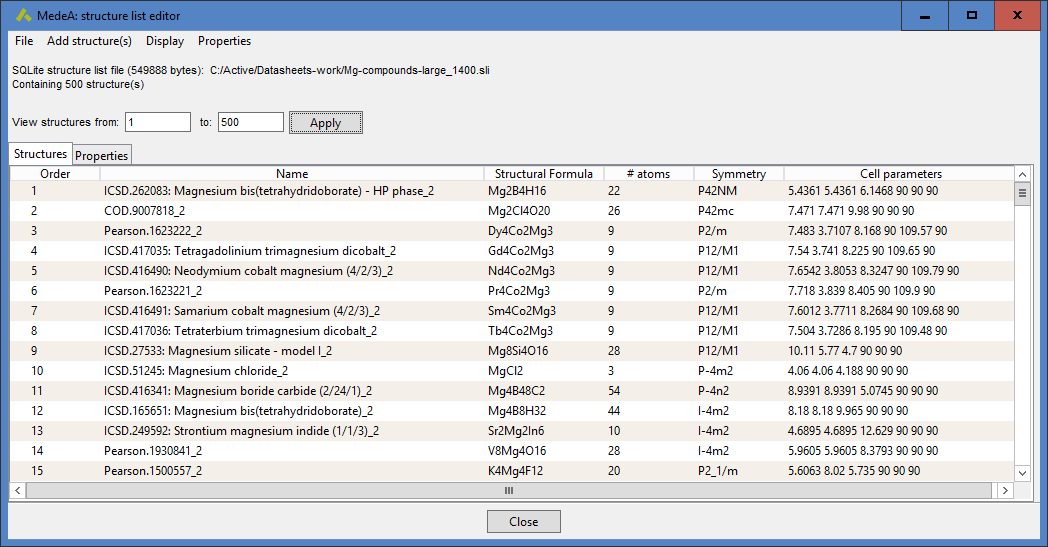MedeA HT-Launchpad - High-throughout Flowchart Computations
At-a-Glance
MedeA [1] HT-Launchpad enables high-throughout calculations for large sets of systems, using a single computational protocol. The input structures can be crystalline materials, amorphous structures, polymers, individual molecules, and fluids as single phases or systems consisting of any combination of the above. A flowchart controls the specific computational steps, such as substituting atoms or scanning ranges of temperature, pressure, and strain. The output is collected in lists that are easily analyzed either in MedeA or in spreadsheets. The module HT-Descriptors and correlation tools within MedeA extend the capabilities of HT-Launchpad, by enabling you to create descriptors based on consistent and large property datasets, thus setting the stage for finding and exploiting correlations.
Key Benefits
- Highly efficient exploration of many design variables, such as chemical composition, strain, temperature, and pressure
- Faster solutions of materials problems from access to large and systematic data sets of structures and properties
- Statistically meaningful results, especially for amorphous systems and polymers, where comprehensive sampling is essential for obtaining reliable properties from simulations
- Straightforward combination of different computational approaches in a single workflow

High-throughout flowchart calculations with MedeA HT-Launchpad.
MedeA HT-Launchpad is particularly well suited for carrying out complex computational protocols involving ab initio, semi-empirical quantum mechanical, and forcefield methods in combination with model building steps, such as systematic replacement of atoms or stepping through ranges of temperature and pressure values. MedeA HT-Launchpad offers a variety of tools and utilities, including tools to create compendia of systems and configurations (structure lists) from MedeA InfoMaticA databases and trajectories, tools to build combinatorial libraries, tools to store structures and results of high-throughout calculations, and utilities for sorting and duplicate removal.
‘High-throughout calculations are changing our way to perform materials modeling. It is like replacing a single tree by a forest.’
Characteristics
MedeA HT-Launchpad (HT stands for “high-throughout”) uses structure lists as primary input. An example of a structure list is shown in the adjacent figure. In this case, a structure list is created by saving a set of desired structures obtained after a search with MedeA InfoMaticA in the comprehensive structural databases. For amorphous polymer materials, the MedeA Amorphous Materials Builder is a source to create structure lists. To build structure lists containing individual molecules, conveniently use SMILES strings and the corresponding tools in MedeA to transform these character strings into 3D-molecular structures.
Structure lists are also created by importing structures from previous computations. This includes the possibility to create a structure list from trajectories from molecular dynamics simulations.

Example of a structure list of Mg-containing compounds. The structures are selected from the databases using the search capabilities of MedeA InfoMaticA, and are exported to a structure list with a few mouse-clicks.
A central operation of the MedeA HT-Launchpad is invoked by the stage “For Each Structure” in MedeA Flowcharts. This stage uses the structure list as primary input, and controls the steps taken for each structure. The steps can be a simple one-step calculation or an elaborate simulation protocol, such as the calculation of elastic coefficients using MedeA VASP or the computation of the density of a liquid as a function of temperature using classical molecular dynamics with MedeA LAMMPS. The results of the computations and associated properties for each of the structures can be written in a table or added directly to a structure list.

Computation of the tensile modulus of atactic polystyrene using MedeA HT-Launchpad for accurate statistical sampling. In this case, the elastic coefficients of 108 polymer configurations have been computed and analyzed using the Hill-Walpole method. The result is a narrow bracket as indicated in blue, in excellent agreement with the experiment.
MedeA HT-Launchpad is highly valuable in obtaining reliable statistical sampling. One such example is the calculation of elastic properties of polymers. The above Figure illustrates this capability for the case of polystyrene. Performing one or a few calculations of the elastic modulus results in values scattered between 1.8 GPa to 3.8 GPa. Invoking MedeA HT-Launchpad, and performing over 100 calculations with a single protocol, enables a Hill-Walpole analysis which narrows the range to 3.13-3.18 GPa. This result is in striking agreement with the experimental value of 3.11 +/- 0.07 GPa reported by Kleiner (1979). Such is the value of high-throughput calculations with MedeA HT-Launchpad which enables the user to obtain statistically meaningful and highly accurate results.
Value of Integration
Required Modules
- MedeA Environment